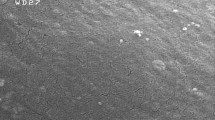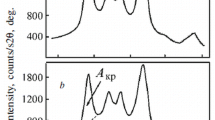Abstract
High Modulus and high tenacity polypropylene fibers have been prepared by drawing on a gradient heater. Results show that fiber properties are significantly affected by temperature profiles of final stage drawing on a gradient heater. The gradient drawn filaments showed superior mechanical properties when compared to filaments drawn over a constant temperature heater. Fibers with initial modulus of 16.4 GPa and tenacity of 670 MPa have been manufactured in the process. The nature of the gradient drawing had a significant effect on end properties. The superior mechanical properties are attributed to the high crystal perfection and crystallinity and low void fractions obtained at high draw ratios when drawn over a gradient heater.
Similar content being viewed by others
References
K. H. Nitta and M. Takayanagi,J. Polym. Sci., B: Polym. Phys.,37, 357 (1999).
K. H. Nitta and M. Takayanagi,J. Polym. Sci., B: Polym. Phys.,38, 1037 (2000).
X. C. Zhang, M. F. Butler, and R. E. Cameron,Polym. Int.,48, 1173 (1999).
I. C. Wang, M. G. Dobb, and J. G. Tomka,J. Text. Ins.,86, 383 (1995).
P. Kar, Ph.D. Dissertation, IIT, Delhi (India), 1998.
I. M. Ward, “Integration of Fundamental Polymer Science & Technology”, Vol. 2, (P. J. Lemstra Ed.), pp.80–82, Chapman and Hall, London, 1998.
L. C. Wang, M. G. Dobb, and J. G. Tomka,J. Text. Ins.,86, 391 (1995).
M. Ahmed, “Polypropylene Fibers — Science and Technology”, Elsevier, Amsterdam, p.389, 1992.
M. Ito, K. Tanaka, and T. Kanamoto.J. Polym. Sci., Polym. Phys.,25, 2127 (1987).
Z. W. Wilchinsky,J. Appl. Phys.,30, 792 (1959).
G. Farrow and D. Preston,Br. J. Appl. Phys.,11, 353 (1960).
Y. Yamamoto, M. Dewasawa, and S. Kinoshita,Sen-i Gakkaishi,38, T-10 (1982).
S. J. Mahajan, K. Bhaumik, and B. L. Deopura,J. Appl. Polym. Sci.,43, 49 (1991).
H. Bodaghi, J. E. Spruiell, and J. L. White, “Fibrillar Structure of PP Filaments”, (H. Bodaghi Ed.), Hanser Publishers, Munich, p.100, 1988.
K. Yamada and M. Takayanagi,J. Appl. Polym. Sci.,27, 2091 (1982).
S. Mukhopadhyay, B. L. Deopura, and R. Alagirusamy,J. Appl. Polym. Sci.,101, 838 (2006).
S. Mukhopadhyay, B. L. Deopura, and R. Alagirusamy,J. Text. Ins.,96, 349 (2005).
Author information
Authors and Affiliations
Corresponding author
Rights and permissions
About this article
Cite this article
Mukhopadhyay, S., Deopura, B.L. & Alagirusamy, R. Mechanical properties of polypropylene filaments drawn on varying post spinning temperature gradients. Fibers Polym 7, 432–435 (2006). https://doi.org/10.1007/BF02875777
Received:
Revised:
Accepted:
Issue Date:
DOI: https://doi.org/10.1007/BF02875777




